Controlling of Photophysical Behavior of Rhenium(I) Complexes with 2,6-Di(thiazol-2-yl)pyridine-Based Ligands by Pendant π-Conjugated Aryl Groups
Abstract
:1. Introduction
2. Results and Discussion
2.1. Synthesis and Characterization
2.2. Redox Properties
2.3. Absorption Spectral Features–Experimental and Theoretical Insight
2.4. Luminescence Studies
2.5. Ultrafast Photodynamics of Representative Complexes 1, 3, 4 and 6
3. Materials and Methods
3.1. Synthesis of [ReCl(CO)3(Arn-dtpy-κ2N)] (1–6)
3.2. Crystal Structure Determination and Refinement
3.3. Physical Measurements
3.4. Computational Details
3.5. Femtosecond Transient Absorption Experiment
4. Conclusions
Supplementary Materials
Author Contributions
Funding
Institutional Review Board Statement
Informed Consent Statement
Data Availability Statement
Conflicts of Interest
References
- Ford, W.E.; Rodgers, M.A.J. Reversible Triplet-Triplet Energy Transfer within a Covalently Linked Bichromophoric Molecule. J. Phys. Chem. 1992, 96, 2917–2920. [Google Scholar] [CrossRef]
- Seth, S.K.; Purkayastha, P. Unusually Large Singlet Oxygen (1O2) Production by Very Weakly Emissive Pyrene-Functionalized Iridium(III) Complex: Interplay between Excited 3ILCT/3IL and 3MLCT States. Eur. J. Inorg. Chem. 2020, 2020, 2990–2997. [Google Scholar] [CrossRef]
- Lincoln, R.; Kohler, L.; Monro, S.; Yin, H.; Stephenson, M.; Zong, R.; Chouai, A.; Dorsey, C.; Hennigar, R.; Thummel, R.P.; et al. Exploitation of Long-Lived 3IL Excited States for Metal–Organic Photodynamic Therapy: Verification in a Metastatic Melanoma Model. J. Am. Chem. Soc. 2013, 135, 17161–17175. [Google Scholar] [CrossRef]
- Kazama, A.; Imai, Y.; Okayasu, Y.; Yamada, Y.; Yuasa, J.; Aoki, S. Design and Synthesis of Cyclometalated Iridium(III) Complexes—Chromophore Hybrids That Exhibit Long-Emission Lifetimes Based on a Reversible Electronic Energy Transfer Mechanism. Inorg. Chem. 2020, 59, 6905–6922. [Google Scholar] [CrossRef] [PubMed]
- Jiang, X.; Peng, J.; Wang, J.; Guo, X.; Zhao, D.; Ma, Y. Iridium-Based High-Sensitivity Oxygen Sensors and Photosensitizers with Ultralong Triplet Lifetimes. ACS Appl. Mater. Interfaces 2016, 8, 3591–3600. [Google Scholar] [CrossRef]
- Denisov, S.A.; Yu, S.; Pozzo, J.-L.; Jonusauskas, G.; McClenaghan, N.D. Harnessing Reversible Electronic Energy Transfer: From Molecular Dyads to Molecular Machines. ChemPhysChem 2016, 17, 1794–1804. [Google Scholar] [CrossRef] [PubMed]
- Lavie-Cambot, A.; Lincheneau, C.; Cantuel, M.; Leydet, Y.; McClenaghan, N.D. Reversible Electronic Energy Transfer: A Means to Govern Excited-State Properties of Supramolecular Systems. Chem. Soc. Rev. 2010, 39, 506–515. [Google Scholar] [CrossRef] [PubMed]
- McClenaghan, N.D.; Leydet, Y.; Maubert, B.; Indelli, M.T.; Campagna, S. Excited-State Equilibration: A Process Leading to Long-Lived Metal-to-Ligand Charge Transfer Luminescence in Supramolecular Systems. Coord. Chem. Rev. 2005, 249, 1336–1350. [Google Scholar] [CrossRef]
- McCusker, C.E.; Chakraborty, A.; Castellano, F.N. Excited State Equilibrium Induced Lifetime Extension in a Dinuclear Platinum(II) Complex. J. Phys. Chem. A 2014, 118, 10391–10399. [Google Scholar] [CrossRef]
- Gu, J.; Yan, Y.; Helbig, B.J.; Huang, Z.; Lian, T.; Schmehl, R.H. The Influence of Ligand Localized Excited States on the Photophysics of Second Row and Third Row Transition Metal Terpyridyl Complexes: Recent Examples and a Case Study. Coord. Chem. Rev. 2015, 282–283, 100–109. [Google Scholar] [CrossRef] [Green Version]
- Medlycott, E.A.; Hanan, G.S. Synthesis and Properties of Mono- and Oligo-Nuclear Ru(II) Complexes of Tridentate Ligands: The Quest for Long-Lived Excited States at Room Temperature. Coord. Chem. Rev. 2006, 250, 1763–1782. [Google Scholar] [CrossRef]
- Eberhard, J.; Peuntinger, K.; Fröhlich, R.; Guldi, D.M.; Mattay, J. Synthesis and Properties of Acridine and Acridinium Dye Functionalized Bis(Terpyridine) Ruthenium(II) Complexes. Eur. J. Org. Chem. 2018, 2018, 2682–2700. [Google Scholar] [CrossRef]
- Howarth, A.J.; Majewski, M.B.; Wolf, M.O. Photophysical Properties and Applications of Coordination Complexes Incorporating Pyrene. Coord. Chem. Rev. 2015, 282, 139–149. [Google Scholar] [CrossRef]
- Medlycott, E.A.; Hanan, G.S.; Loiseau, F.; Campagna, S. Tuning the Excited-State Energy of the Organic Chromophore in Bichromophoric Systems Based on the RuII Complexes of Tridentate Ligands. Chem. A Eur. J. 2007, 13, 2837–2846. [Google Scholar] [CrossRef]
- Yarnell, J.E.; Deaton, J.C.; McCusker, C.E.; Castellano, F.N. Bidirectional “Ping-Pong” Energy Transfer and 3000-Fold Lifetime Enhancement in a Re(I) Charge Transfer Complex. Inorg. Chem. 2011, 50, 7820–7830. [Google Scholar] [CrossRef]
- Yarnell, J.E.; Wells, K.A.; Palmer, J.R.; Breaux, J.M.; Castellano, F.N. Excited-State Triplet Equilibria in a Series of Re(I)-Naphthalimide Bichromophores. J. Phys. Chem. B 2019, 123, 7611–7627. [Google Scholar] [CrossRef] [PubMed]
- Schubert, U.S.; Eschbaumer, C.; Hien, O.; Andres, P.R. 4′-Functionalized 2,2′:6′,2″-Terpyridines as Building Blocks for Supramolecular Chemistry and Nanoscience. Tetrahedron Lett. 2001, 42, 4705–4707. [Google Scholar] [CrossRef]
- Lainé, P.; Bedioui, F.; Ochsenbein, P.; Marvaud, V.; Bonin, M.; Amouyal, E. A New Class of Functionalized Terpyridyl Ligands as Building Blocks for Photosensitized Supramolecular Architectures. Synthesis, Structural, and Electronic Characterizations. J. Am. Chem. Soc. 2002, 124, 1364–1377. [Google Scholar] [CrossRef]
- Zych, D.; Slodek, A.; Matussek, M.; Filapek, M.; Szafraniec-Gorol, G.; Maślanka, S.; Krompiec, S.; Kotowicz, S.; Schab-Balcerzak, E.; Smolarek, K.; et al. 4′-Phenyl-2,2′:6′,2″-Terpyridine Derivatives-Synthesis, Potential Application and the Influence of Acetylene Linker on Their Properties. Dye. Pigment. 2017, 146, 331–343. [Google Scholar] [CrossRef]
- Wang, L.; Song, B.; Khalife, S.; Li, Y.; Ming, L.-J.; Bai, S.; Xu, Y.; Yu, H.; Wang, M.; Wang, H.; et al. Introducing Seven Transition Metal Ions into Terpyridine-Based Supramolecules: Self-Assembly and Dynamic Ligand Exchange Study. J. Am. Chem. Soc. 2020, 142, 1811–1821. [Google Scholar] [CrossRef]
- Ma, J.; Lu, T.; Duan, X.; Xu, Y.; Li, Z.; Li, K.; Shi, J.; Bai, Q.; Zhang, Z.; Hao, X.-Q.; et al. Designing Narcissistic Self-Sorting Terpyridine Moieties with High Coordination Selectivity for Complex Metallo-Supramolecules. Commun Chem 2021, 4, 136. [Google Scholar] [CrossRef]
- Housecroft, C.E.; Constable, E.C. The Terpyridine Isomer Game: From Chelate to Coordination Network Building Block. Chem. Commun. 2020, 56, 10786–10794. [Google Scholar] [CrossRef] [PubMed]
- Agosti, A.; Kuna, E.; Bergamini, G. Divergent Terpyridine-Based Coordination for the Construction of Photoactive Supramolecular Structures. Eur. J. Inorg. Chem. 2019, 2019, 577–584. [Google Scholar] [CrossRef]
- Musiol, R.; Malecki, P.; Pacholczyk, M.; Mularski, J. Terpyridines as Promising Antitumor Agents: An Overview of Their Discovery and Development. Expert Opin. Drug Discov. 2022, 17, 259–271. [Google Scholar] [CrossRef] [PubMed]
- Liu, J.; Chen, M.; Wang, Y.; Zhao, X.; Wang, S.; Wu, Y.; Zhang, W. Synthesis and the Interaction of 2-(1 H -Pyrazol-4-Yl)-1 H -Imidazo[4,5-f][1,10]Phenanthrolines with Telomeric DNA as Lung Cancer Inhibitors. Eur. J. Med. Chem. 2017, 133, 36–49. [Google Scholar] [CrossRef] [PubMed]
- Malarz, K.; Zych, D.; Gawecki, R.; Kuczak, M.; Musioł, R.; Mrozek-Wilczkiewicz, A. New Derivatives of 4′-Phenyl-2,2′:6′,2″-Terpyridine as Promising Anticancer Agents. Eur. J. Med. Chem. 2021, 212, 113032. [Google Scholar] [CrossRef]
- Ge, C.; Zhu, J.; Ouyang, A.; Lu, N.; Wang, Y.; Zhang, Q.; Zhang, P. Near-infrared phosphorescent terpyridine osmium(ii) photosensitizer complexes for photodynamic and photooxidation therapy. Inorg. Chem. Front. 2020, 7, 4020–4027. [Google Scholar] [CrossRef]
- Qin, Q.-P.; Wang, Z.-F.; Wang, S.-L.; Luo, D.-M.; Zou, B.-Q.; Yao, P.-F.; Tan, M.-X.; Liang, H. In Vitro and in Vivo Antitumor Activities of Three Novel Binuclear Platinum(II) Complexes with 4′-Substituted-2,2′:6′,2″-Terpyridine Ligands. Eur. J. Med. Chem. 2019, 170, 195–202. [Google Scholar] [CrossRef]
- Cummings, S.D. Platinum Complexes of Terpyridine: Interaction and Reactivity with Biomolecules. Coord. Chem. Rev. 2009, 253, 1495–1516. [Google Scholar] [CrossRef]
- Taniya, O.S.; Kopchuk, D.S.; Khasanov, A.F.; Kovalev, I.S.; Santra, S.; Zyryanov, G.V.; Majee, A.; Charushin, V.N.; Chupakhin, O.N. Synthetic Approaches and Supramolecular Properties of 2,2′:N′,M″-Terpyridine Domains (N = 3,4,5,6; M = 2,3,4) Based on the 2,2′-Bipyridine Core as Ligands with K2N-Bidentate Coordination Mode. Coord. Chem. Rev. 2021, 442, 213980. [Google Scholar] [CrossRef]
- Maroń, A.; Szlapa, A.; Klemens, T.; Kula, S.; Machura, B.; Krompiec, S.; Małecki, J.G.; Świtlicka-Olszewska, A.; Erfurt, K.; Chrobok, A. Tuning the Photophysical Properties of 4′-Substituted Terpyridines—An Experimental and Theoretical Study. Org. Biomol. Chem. 2016, 14, 3793–3808. [Google Scholar] [CrossRef] [PubMed]
- Szlapa-Kula, A.; Małecka, M.; Machura, B. Insight into Structure-Property Relationships of Aryl-Substituted 2,2′:6′,2″-Terpyridines. Dye. Pigment. 2020, 180, 108480. [Google Scholar] [CrossRef]
- Maroń, A.; Kula, S.; Szlapa-Kula, A.; Świtlicka, A.; Machura, B.; Krompiec, S.; Małecki, J.G.; Kruszyński, R.; Chrobok, A.; Schab-Balcerzak, E.; et al. 2,2′:6′,2′′-Terpyridine Analogues: Structural, Electrochemical, and Photophysical Properties of 2,6-Di(Thiazol-2-Yl)Pyridine Derivatives. Eur. J. Org. Chem. 2017, 2017, 2730–2745. [Google Scholar] [CrossRef]
- Choroba, K.; Kula, S.; Maroń, A.; Machura, B.; Małecki, J.; Szłapa-Kula, A.; Siwy, M.; Grzelak, J.; Maćkowski, S.; Schab-Balcerzak, E. Aryl Substituted 2,6-Di(Thiazol-2-Yl)Pyridines –Excited-State Characterization and Potential for OLEDs. Dye. Pigment. 2019, 169, 89–104. [Google Scholar] [CrossRef]
- Małecka, M.; Machura, B.; Szlapa-Kula, A. Optical Properties of 2,6-Di(Pyrazin-2-Yl)Pyridines Substituted with Extended Aryl Groups. Dye. Pigment. 2021, 188, 109168. [Google Scholar] [CrossRef]
- Klemens, T.; Świtlicka, A.; Machura, B.; Kula, S.; Krompiec, S.; Łaba, K.; Korzec, M.; Siwy, M.; Janeczek, H.; Schab-Balcerzak, E.; et al. A Family of Solution Processable Ligands and Their Re(I) Complexes towards Light Emitting Applications. Dye. Pigment. 2019, 163, 86–101. [Google Scholar] [CrossRef]
- Klemens, T.; Świtlicka, A.; Szlapa-Kula, A.; Łapok, Ł.; Obłoza, M.; Siwy, M.; Szalkowski, M.; Maćkowski, S.; Libera, M.; Schab-Balcerzak, E.; et al. Tuning Optical Properties of Re(I) Carbonyl Complexes by Modifying Push–Pull Ligands Structure. Organometallics 2019, 38, 4206–4223. [Google Scholar] [CrossRef]
- Klemens, T.; Świtlicka, A.; Szlapa-Kula, A.; Krompiec, S.; Lodowski, P.; Chrobok, A.; Godlewska, M.; Kotowicz, S.; Siwy, M.; Bednarczyk, K.; et al. Experimental and Computational Exploration of Photophysical and Electroluminescent Properties of Modified 2,2′:6′,2″-Terpyridine, 2,6-Di(Thiazol-2-Yl)Pyridine and 2,6-Di(Pyrazin-2-Yl)Pyridine Ligands and Their Re(I) Complexes. Appl. Organomet. Chem. 2018, 32, e4611. [Google Scholar] [CrossRef]
- Klemens, T.; Czerwińska, K.; Szlapa-Kula, A.; Kula, S.; Świtlicka, A.; Kotowicz, S.; Siwy, M.; Bednarczyk, K.; Krompiec, S.; Smolarek, K.; et al. Synthesis, Spectroscopic, Electrochemical and Computational Studies of Rhenium(I) Tricarbonyl Complexes Based on Bidentate-Coordinated 2,6-Di(Thiazol-2-Yl)Pyridine Derivatives. Dalton Trans. 2017, 46, 9605–9620. [Google Scholar] [CrossRef]
- Choroba, K.; Machura, B.; Raposo, L.R.; Małecki, J.G.; Kula, S.; Pająk, M.; Erfurt, K.; Maroń, A.M.; Fernandes, A.R. Platinum(II) Complexes Showing High Cytotoxicity toward A2780 Ovarian Carcinoma Cells. Dalton Trans. 2019, 48, 13081–13093. [Google Scholar] [CrossRef]
- Li, L.; Du, K.; Wang, Y.; Jia, H.; Hou, X.; Chao, H.; Ji, L. Self-Activating Nuclease and Anticancer Activities of Copper( Ii ) Complexes with Aryl-Modified 2,6-Di(Thiazol-2-Yl)Pyridine. Dalton Trans. 2013, 42, 11576–11588. [Google Scholar] [CrossRef] [PubMed]
- Yu, H.; Liu, J.; Hao, Z.; He, J.; Sun, M.; Hu, S.; Yu, L.; Chao, H. Synthesis, Characterization and Biological Evaluation of Ruthenium(II) Complexes [Ru(Dtzp)(Dppz)Cl]+ and [Ru(Dtzp)(Dppz)CH3CN]2+ for Photodynamic Therapy. Dye. Pigment. 2017, 136, 416–426. [Google Scholar] [CrossRef]
- Li, G.-Y.; Du, K.-J.; Wang, J.-Q.; Liang, J.-W.; Kou, J.-F.; Hou, X.-J.; Ji, L.-N.; Chao, H. Synthesis, Crystal Structure, DNA Interaction and Anticancer Activity of Tridentate Copper(II) Complexes. J. Inorg. Biochem. 2013, 119, 43–53. [Google Scholar] [CrossRef] [PubMed]
- Zeng, L.; Chen, Y.; Huang, H.; Wang, J.; Zhao, D.; Ji, L.; Chao, H. Cyclometalated Ruthenium(II) Anthraquinone Complexes Exhibit Strong Anticancer Activity in Hypoxic Tumor Cells. Chem. A Eur. J. 2015, 21, 15308–15319. [Google Scholar] [CrossRef]
- Medlycott, A.E.; Hanan, S.G. Designing Tridentate Ligands for Ruthenium( Ii ) Complexes with Prolonged Room Temperature Luminescence Lifetimes. Chem. Soc. Rev. 2005, 34, 133–142. [Google Scholar] [CrossRef] [PubMed]
- Qin, Q.-P.; Liu, Y.-C.; Wang, H.-L.; Qin, J.-L.; Cheng, F.-J.; Tang, S.-F.; Liang, H. Synthesis and Antitumor Mechanisms of a Copper(Ii) Complex of Anthracene-9-Imidazoline Hydrazone (9-AIH). Metallomics 2015, 7, 1124–1136. [Google Scholar] [CrossRef]
- Jaividhya, P.; Ganeshpandian, M.; Dhivya, R.; Abdulkadher Akbarsha, M.; Palaniandavar, M. Fluorescent Mixed Ligand Copper(Ii) Complexes of Anthracene-Appended Schiff Bases: Studies on DNA Binding, Nuclease Activity and Cytotoxicity. Dalton Trans. 2015, 44, 11997–12010. [Google Scholar] [CrossRef]
- Gama, S.; Rodrigues, I.; Mendes, F.; Santos, I.C.; Gabano, E.; Klejevskaja, B.; Gonzalez-Garcia, J.; Ravera, M.; Vilar, R.; Paulo, A. Anthracene-Terpyridine Metal Complexes as New G-Quadruplex DNA Binders. J. Inorg. Biochem. 2016, 160, 275–286. [Google Scholar] [CrossRef]
- Kuncewicz, J.; Dąbrowski, J.M.; Kyzioł, A.; Brindell, M.; Łabuz, P.; Mazuryk, O.; Macyk, W.; Stochel, G. Perspectives of Molecular and Nanostructured Systems with D- and f-Block Metals in Photogeneration of Reactive Oxygen Species for Medical Strategies. Coord. Chem. Rev. 2019, 398, 113012. [Google Scholar] [CrossRef]
- Pan, Z.-Y.; Cai, D.-H.; He, L. Dinuclear Phosphorescent Rhenium(I) Complexes as Potential Anticancer and Photodynamic Therapy Agents. Dalton Trans. 2020, 49, 11583–11590. [Google Scholar] [CrossRef]
- Sell, A.C.; Wetzel, J.C.; Schmitz, M.; Maijenburg, A.W.; Woltersdorf, G.; Naumann, R.; Kerzig, C. Water-Soluble Ruthenium Complex-Pyrene Dyads with Extended Triplet Lifetimes for Efficient Energy Transfer Applications. Dalton Trans. 2022, 51, 10799–10808. [Google Scholar] [CrossRef] [PubMed]
- Lu, C.; Xu, W.; Shah, H.; Liu, B.; Xu, W.; Sun, L.; Qian, S.Y.; Sun, W. In Vitro Photodynamic Therapy of Mononuclear and Dinuclear Iridium(III) Bis(Terpyridine) Complexes. ACS Appl. Bio Mater. 2020, 3, 6865–6875. [Google Scholar] [CrossRef] [PubMed]
- Liu, B.; Monro, S.; Li, Z.; Jabed, M.A.; Ramirez, D.; Cameron, C.G.; Colón, K.; Roque, J.; Kilina, S.; Tian, J.; et al. New Class of Homoleptic and Heteroleptic Bis(Terpyridine) Iridium(III) Complexes with Strong Photodynamic Therapy Effects. ACS Appl. Bio Mater. 2019, 2, 2964–2977. [Google Scholar] [CrossRef] [PubMed]
- Rohrabaugh, T.N., Jr.; Collins, K.A.; Xue, C.; White, J.K.; Kodanko, J.J.; Turro, C. New Ru(Ii) Complex for Dual Photochemotherapy: Release of Cathepsin K Inhibitor and 1 O 2 Production. Dalton Trans. 2018, 47, 11851–11858. [Google Scholar] [CrossRef]
- Szlapa-Kula, A.; Małecka, M.; Maroń, A.M.; Janeczek, H.; Siwy, M.; Schab-Balcerzak, E.; Szalkowski, M.; Maćkowski, S.; Pedzinski, T.; Erfurt, K.; et al. In-Depth Studies of Ground- and Excited-State Properties of Re(I) Carbonyl Complexes Bearing 2,2′:6′,2″-Terpyridine and 2,6-Bis(Pyrazin-2-Yl)Pyridine Coupled with π-Conjugated Aryl Chromophores. Inorg. Chem. 2021, 60, 18726–18738. [Google Scholar] [CrossRef]
- King, A.P.; Marker, S.C.; Swanda, R.V.; Woods, J.J.; Qian, S.-B.; Wilson, J.J. A Rhenium Isonitrile Complex Induces Unfolded Protein Response-Mediated Apoptosis in Cancer Cells. Chem. A Eur. J. 2019, 25, 9206–9210. [Google Scholar] [CrossRef]
- Marker, S.C.; King, A.P.; Granja, S.; Vaughn, B.; Woods, J.J.; Boros, E.; Wilson, J.J. Exploring the In Vivo and In Vitro Anticancer Activity of Rhenium Isonitrile Complexes. Inorg. Chem. 2020, 59, 10285–10303. [Google Scholar] [CrossRef]
- Bauer, E.B.; Haase, A.A.; Reich, R.M.; Crans, D.C.; Kühn, F.E. Organometallic and Coordination Rhenium Compounds and Their Potential in Cancer Therapy. Coord. Chem. Rev. 2019, 393, 79–117. [Google Scholar] [CrossRef]
- Yang, J.; Zhao, J.-X.; Cao, Q.; Hao, L.; Zhou, D.; Gan, Z.; Ji, L.-N.; Mao, Z.-W. Simultaneously Inducing and Tracking Cancer Cell Metabolism Repression by Mitochondria-Immobilized Rhenium(I) Complex. ACS Appl. Mater. Interfaces 2017, 9, 13900–13912. [Google Scholar] [CrossRef]
- Wang, F.-X.; Liang, J.-H.; Zhang, H.; Wang, Z.-H.; Wan, Q.; Tan, C.-P.; Ji, L.-N.; Mao, Z.-W. Mitochondria-Accumulating Rhenium(I) Tricarbonyl Complexes Induce Cell Death via Irreversible Oxidative Stress and Glutathione Metabolism Disturbance. ACS Appl. Mater. Interfaces 2019, 11, 13123–13133. [Google Scholar] [CrossRef]
- Pan, Z.-Y.; Tan, C.-P.; Rao, L.-S.; Zhang, H.; Zheng, Y.; Hao, L.; Ji, L.-N.; Mao, Z.-W. Recoding the Cancer Epigenome by Intervening in Metabolism and Iron Homeostasis with Mitochondria-Targeted Rhenium(I) Complexes. Angew. Chem. Int. Ed. 2020, 59, 18755–18762. [Google Scholar] [CrossRef] [PubMed]
- He, S.-F.; Pan, N.-L.; Chen, B.-B.; Liao, J.-X.; Huang, M.; Qiu, H.-J.; Jiang, D.-C.; Wang, J.-J.; Chen, J.-X.; Sun, J. Mitochondria-Targeted Re(I) Complexes Bearing Guanidinium as Ligands and Their Anticancer Activity. J. Biol. Inorg. Chem. 2020, 25, 1107–1116. [Google Scholar] [CrossRef] [PubMed]
- Marker, S.C.; King, A.P.; Swanda, R.V.; Vaughn, B.; Boros, E.; Qian, S.-B.; Wilson, J.J. Exploring Ovarian Cancer Cell Resistance to Rhenium Anticancer Complexes. Angew. Chem. Int. Ed. 2020, 59, 13391–13400. [Google Scholar] [CrossRef] [PubMed]
- Bujak, P.; Kulszewicz-Bajer, I.; Zagorska, M.; Maurel, V.; Wielgus, I.; Pron, A. Polymers for Electronics and Spintronics. Chem. Soc. Rev. 2013, 42, 8895–8999. [Google Scholar] [CrossRef] [PubMed]
- Mongal, B.N.; Bhattacharya, S.; Mandal, T.K.; Datta, J.; Naskar, S. Synthesis, Characterization and Photovoltaic Studies of 2,2′;6′,2″-Terpyridine-Based Ruthenium Complexes with Phenylamino, Anthranyl and Furfuryl Substitutions at the 4′-Position. J. Coord. Chem. 2021, 74, 1382–1398. [Google Scholar] [CrossRef]
- Nie, Q.; Xie, Y.; Huang, W.; Wu, D. A Dynamic Heterometal–Organic Rhomboid Exhibiting Thermochromic and Piezochromic Luminescence. Inorg. Chem. 2018, 57, 14489–14492. [Google Scholar] [CrossRef]
- Rodríguez, L.; Ferrer, M.; Rossell, O.; Duarte, F.J.S.; Gil Santos, A.; Lima, J.C. Solvent Effects on the Absorption and Emission of [Re(R2bpy)(CO)3X] Complexes and Their Sensitivity to CO2 in Solution. J. Photochem. Photobiol. A Chem. 2009, 204, 174–182. [Google Scholar] [CrossRef]
- Lever, A.B.P. Inorganic Electronic Spectroscopy; Elsevier: Amsterdam, The Netherlands, 1984. [Google Scholar]
- Tyson, D.S.; Luman, C.R.; Zhou, X.; Castellano, F.N. New Ru(II) Chromophores with Extended Excited-State Lifetimes. Inorg. Chem. 2001, 40, 4063–4071. [Google Scholar] [CrossRef]
- Yarnell, J.E.; McCusker, C.E.; Leeds, A.J.; Breaux, J.M.; Castellano, F.N. Exposing the Excited-State Equilibrium in an IrIII Bichromophore: A Combined Time Resolved Spectroscopy and Computational Study. Eur. J. Inorg. Chem. 2016, 2016, 1808–1818. [Google Scholar] [CrossRef]
- Wells, K.A.; Yarnell, J.E.; Palmer, J.R.; Lee, T.S.; Papa, C.M.; Castellano, F.N. Energy Migration Processes in Re(I) MLCT Complexes Featuring a Chromophoric Ancillary Ligand. Inorg. Chem. 2020, 59, 8259–8271. [Google Scholar] [CrossRef]
- Yarnell, J.E.; Chakraborty, A.; Myahkostupov, M.; Wright, K.M.; Castellano, F.N. Long-Lived Triplet Excited State in a Platinum(II) Perylene Monoimide Complex. Dalton Trans. 2018, 47, 15071–15081. [Google Scholar] [CrossRef] [PubMed]
- Wallace, L.; Rillema, D.P. Photophysical Properties of Rhenium(I) Tricarbonyl Complexes Containing Alkyl- and Aryl-Substituted Phenanthrolines as Ligands. Inorg. Chem. 1993, 32, 3836–3843. [Google Scholar] [CrossRef]
- Kisel, K.S.; Eskelinen, T.; Zafar, W.; Solomatina, A.I.; Hirva, P.; Grachova, E.V.; Tunik, S.P.; Koshevoy, I.O. Chromophore-Functionalized Phenanthro-Diimine Ligands and Their Re(I) Complexes. Inorg. Chem. 2018, 57, 6349–6361. [Google Scholar] [CrossRef] [PubMed]
- Li, Q.; Guo, H.; Ma, L.; Wu, W.; Liu, Y.; Zhao, J. Tuning the Photophysical Properties of N^NPt(II) Bisacetylide Complexes with Fluorene Moiety and Its Applications for Triplet–Triplet-Annihilation Based Upconversion. J. Mater. Chem. 2012, 22, 5319–5329. [Google Scholar] [CrossRef]
- El Nahhas, A.; Consani, C.; Blanco-Rodríguez, A.M.; Lancaster, K.M.; Braem, O.; Cannizzo, A.; Towrie, M.; Clark, I.P.; Záliš, S.; Chergui, M.; et al. Ultrafast Excited-State Dynamics of Rhenium(I) Photosensitizers [Re(Cl)(CO)3(N,N)] and [Re(Imidazole)(CO)3(N,N)]+: Diimine Effects. Inorg. Chem. 2011, 50, 2932–2943. [Google Scholar] [CrossRef]
- El Nahhas, A.; Cannizzo, A.; van Mourik, F.; Blanco-Rodríguez, A.M.; Záliš, S.; Vlček, A.; Chergui, M. Ultrafast Excited-State Dynamics of [Re(L)(CO)3(Bpy)] n Complexes: Involvement of the Solvent. J. Phys. Chem. A 2010, 114, 6361–6369. [Google Scholar] [CrossRef]
- Cannizzo, A.; Blanco-Rodríguez, A.M.; El Nahhas, A.; Šebera, J.; Záliš, S.; Vlček, A.; Chergui, M. Femtosecond Fluorescence and Intersystem Crossing in Rhenium(I) Carbonyl−Bipyridine Complexes. J. Am. Chem. Soc. 2008, 130, 8967–8974. [Google Scholar] [CrossRef]
- Choroba, K.; Kotowicz, S.; Maroń, A.; Świtlicka, A.; Szłapa-Kula, A.; Siwy, M.; Grzelak, J.; Sulowska, K.; Maćkowski, S.; Schab-Balcerzak, E.; et al. Ground- and Excited-State Properties of Re(I) Carbonyl Complexes—Effect of Triimine Ligand Core and Appended Heteroaromatic Groups. Dye. Pigment. 2021, 192, 109472. [Google Scholar] [CrossRef]
- Lauer, A.; Dobryakov, A.L.; Kovalenko, S.A.; Fidder, H.; Heyne, K. Dual Photochemistry of Anthracene-9,10-Endoperoxide Studied by Femtosecond Spectroscopy. Phys. Chem. Chem. Phys. 2011, 13, 8723–8732. [Google Scholar] [CrossRef]
- Carlotti, B.; Flamini, R.; Spalletti, A.; Marrocchi, A.; Elisei, F. Comprehensive Photophysical Behaviour of Ethynyl Fluorenes and Ethynyl Anthracenes Investigated by Fast and Ultrafast Time-Resolved Spectroscopy. ChemPhysChem 2012, 13, 724–735. [Google Scholar] [CrossRef]
- Reineke, S.; Baldo, M.A. Room Temperature Triplet State Spectroscopy of Organic Semiconductors. Sci. Rep. 2014, 4, 3797. [Google Scholar] [CrossRef] [PubMed]
- Hou, Y.; Biskup, T.; Rein, S.; Wang, Z.; Bussotti, L.; Russo, N.; Foggi, P.; Zhao, J.; Di Donato, M.; Mazzone, G.; et al. Spin–Orbit Charge Recombination Intersystem Crossing in Phenothiazine–Anthracene Compact Dyads: Effect of Molecular Conformation on Electronic Coupling, Electronic Transitions, and Electron Spin Polarizations of the Triplet States. J. Phys. Chem. C 2018, 122, 27850–27865. [Google Scholar] [CrossRef]
- Yang, W.; Zhao, J.; Tang, G.; Li, X.; Gurzadyan, G.G. Direct Observation of Long-Lived Upper Excited Triplet States and Intersystem Crossing in Anthracene-Containing PtII Complexes. J. Phys. Chem. Lett. 2019, 10, 7767–7773. [Google Scholar] [CrossRef]
- Wu, T.; Jiang, S.; Narayan Samanta, P.; Xie, Y.; Li, J.; Wang, X.; Devashis, M.; Gu, X.; Wang, Y.; Huang, W.; et al. Negative Thermal Quenching of Photoluminescence in a Copper–Organic Framework Emitter. Chem. Commun. 2020, 56, 12057–12060. [Google Scholar] [CrossRef] [PubMed]
- Maroń, A.M.; Szlapa-Kula, A.; Matussek, M.; Kruszynski, R.; Siwy, M.; Janeczek, H.; Grzelak, J.; Maćkowski, S.; Schab-Balcerzak, E.; Machura, B. Photoluminescence Enhancement of Re(I) Carbonyl Complexes Bearing D–A and D–π–A Ligands. Dalton Trans. 2020, 49, 4441–4453. [Google Scholar] [CrossRef]
- CrysAlisRED, version 1.171.37.35g; Oxford Diffraction Ltd.: Abingdon, UK, 2014.
- Sheldrick, G.M. A Short History of SHELX. Acta Cryst A 2008, 64, 112–122. [Google Scholar] [CrossRef]
- Sheldrick, G.M. SHELXT—Integrated Space-Group and Crystal-Structure Determination. Acta Cryst A 2015, 71, 3–8. [Google Scholar] [CrossRef]
- Dolomanov, O.V.; Bourhis, L.J.; Gildea, R.J.; Howard, J.a.K.; Puschmann, H. OLEX2: A Complete Structure Solution, Refinement and Analysis Program. J Appl Cryst 2009, 42, 339–341. [Google Scholar] [CrossRef]
- Frisch, M.J.; Trucks, G.W.; Schlegel, H.B.; Scuseria, G.E.; Robb, M.A.; Cheeseman, J.R.; Scalmani, G.; Barone, V.; Petersson, G.A.; Nakatsuji, H.; et al. Gaussian 16, Revision C.01; Gaussian, Inc.: Wallingford, CT, USA, 2016. [Google Scholar]
- Perdew, J.P.; Burke, K.; Ernzerhof, M. Generalized Gradient Approximation Made Simple. Phys. Rev. Lett. 1996, 77, 3865–3868. [Google Scholar] [CrossRef]
- Adamo, C.; Barone, V. Toward Reliable Density Functional Methods without Adjustable Parameters: The PBE0 Model. J. Chem. Phys. 1999, 110, 6158–6170. [Google Scholar] [CrossRef]
- Weigend, F.; Ahlrichs, R. Balanced Basis Sets of Split Valence, Triple Zeta Valence and Quadruple Zeta Valence Quality for H to Rn: Design and Assessment of Accuracy. Phys. Chem. Chem. Phys. 2005, 7, 3297–3305. [Google Scholar] [CrossRef] [PubMed]
- Rappoport, D.; Furche, F. Property-Optimized Gaussian Basis Sets for Molecular Response Calculations. J. Chem. Phys. 2010, 133, 134105. [Google Scholar] [CrossRef] [PubMed]
- Andrae, D.; Häußermann, U.; Dolg, M.; Stoll, H.; Preuß, H. Energy-Adjustedab Initio Pseudopotentials for the Second and Third Row Transition Elements. Theoret. Chim. Acta 1990, 77, 123–141. [Google Scholar] [CrossRef]
- Cancès, E.; Mennucci, B.; Tomasi, J. A New Integral Equation Formalism for the Polarizable Continuum Model: Theoretical Background and Applications to Isotropic and Anisotropic Dielectrics. J. Chem. Phys. 1997, 107, 3032–3041. [Google Scholar] [CrossRef]
- Mennucci, B.; Tomasi, J. Continuum Solvation Models: A New Approach to the Problem of Solute’s Charge Distribution and Cavity Boundaries. J. Chem. Phys. 1997, 106, 5151–5158. [Google Scholar] [CrossRef]
- Cossi, M.; Barone, V.; Mennucci, B.; Tomasi, J. Ab Initio Study of Ionic Solutions by a Polarizable Continuum Dielectric Model. Chem. Phys. Lett. 1998, 286, 253–260. [Google Scholar] [CrossRef]
- Slavov, C.; Hartmann, H.; Wachtveitl, J. Implementation and Evaluation of Data Analysis Strategies for Time-Resolved Optical Spectroscopy. Anal. Chem. 2015, 87, 2328–2336. [Google Scholar] [CrossRef]
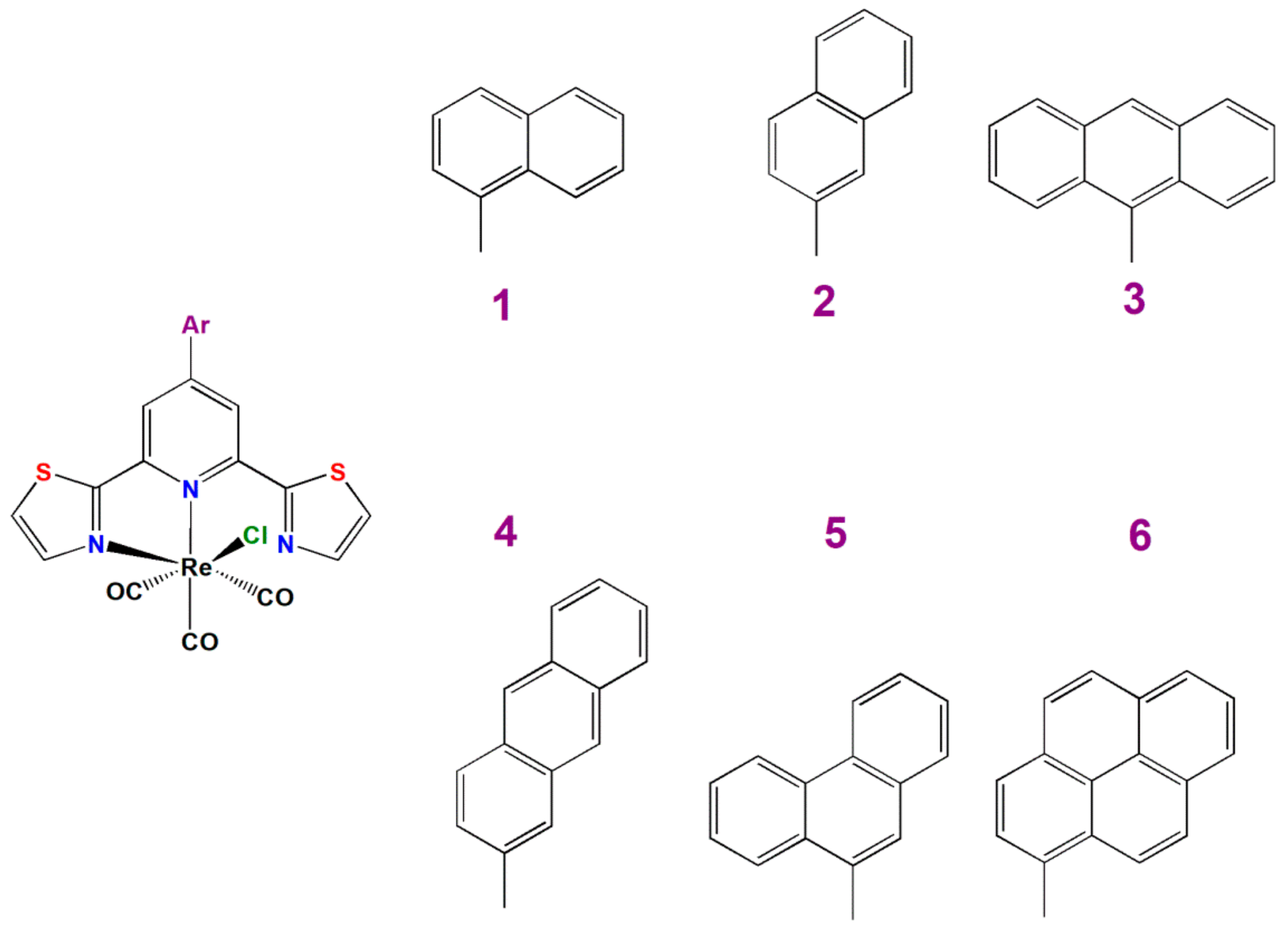


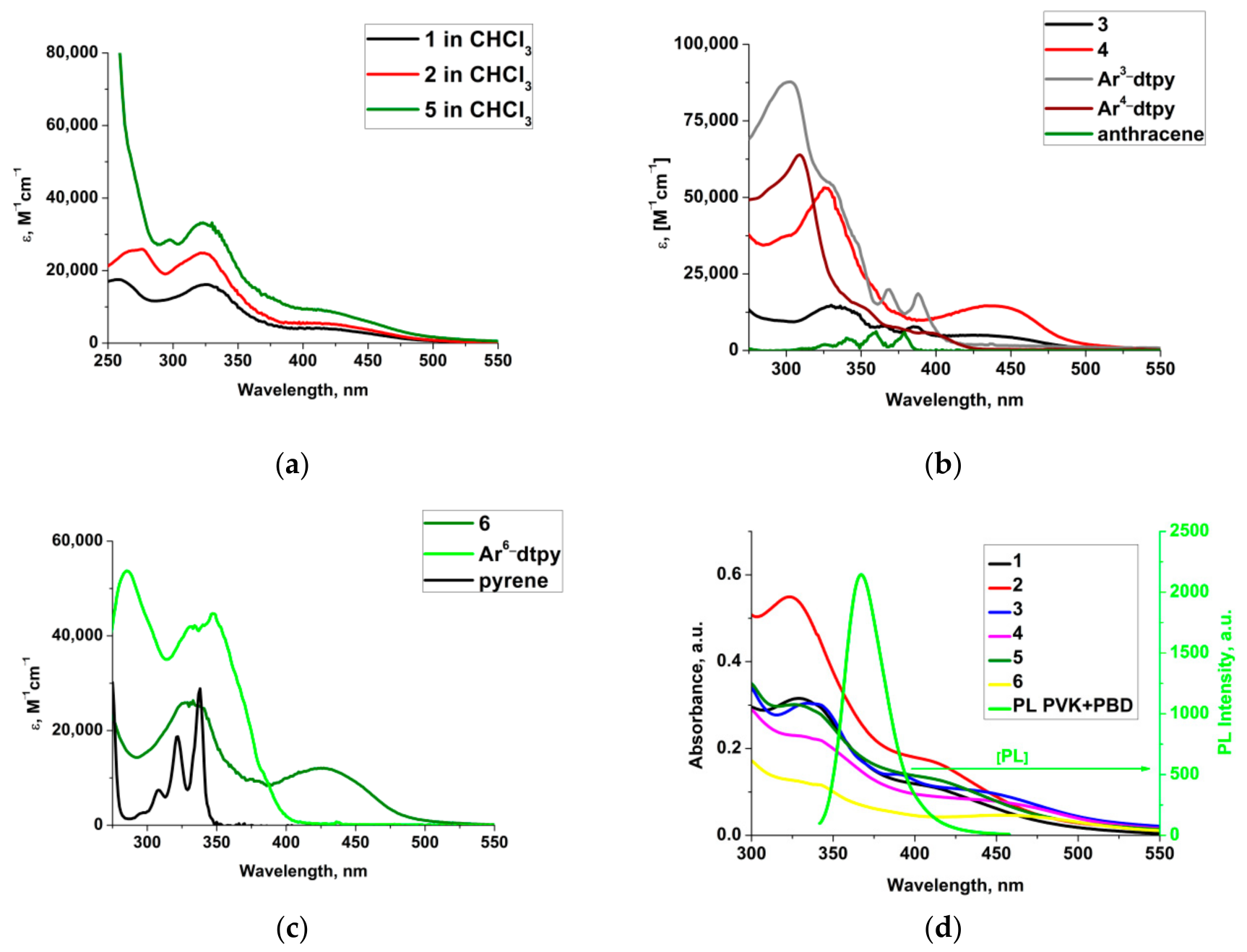
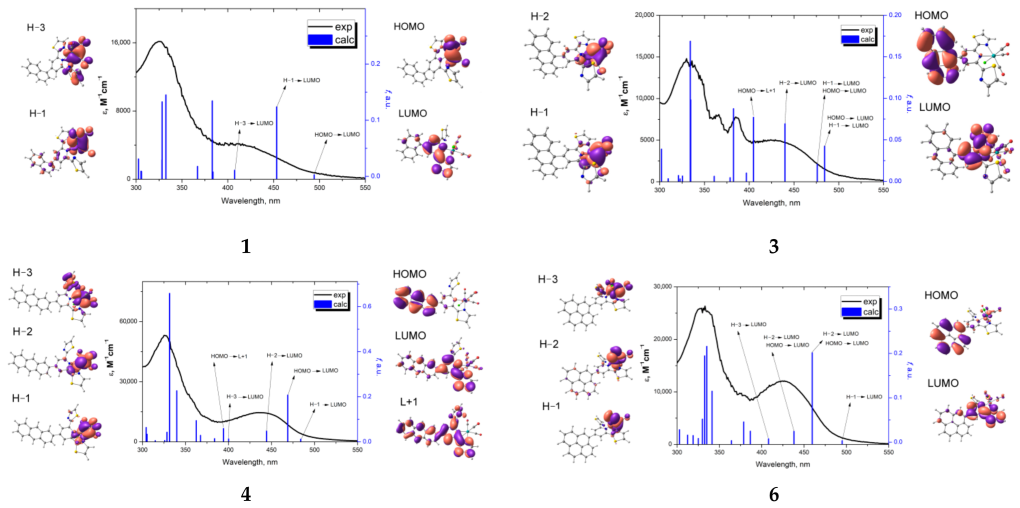

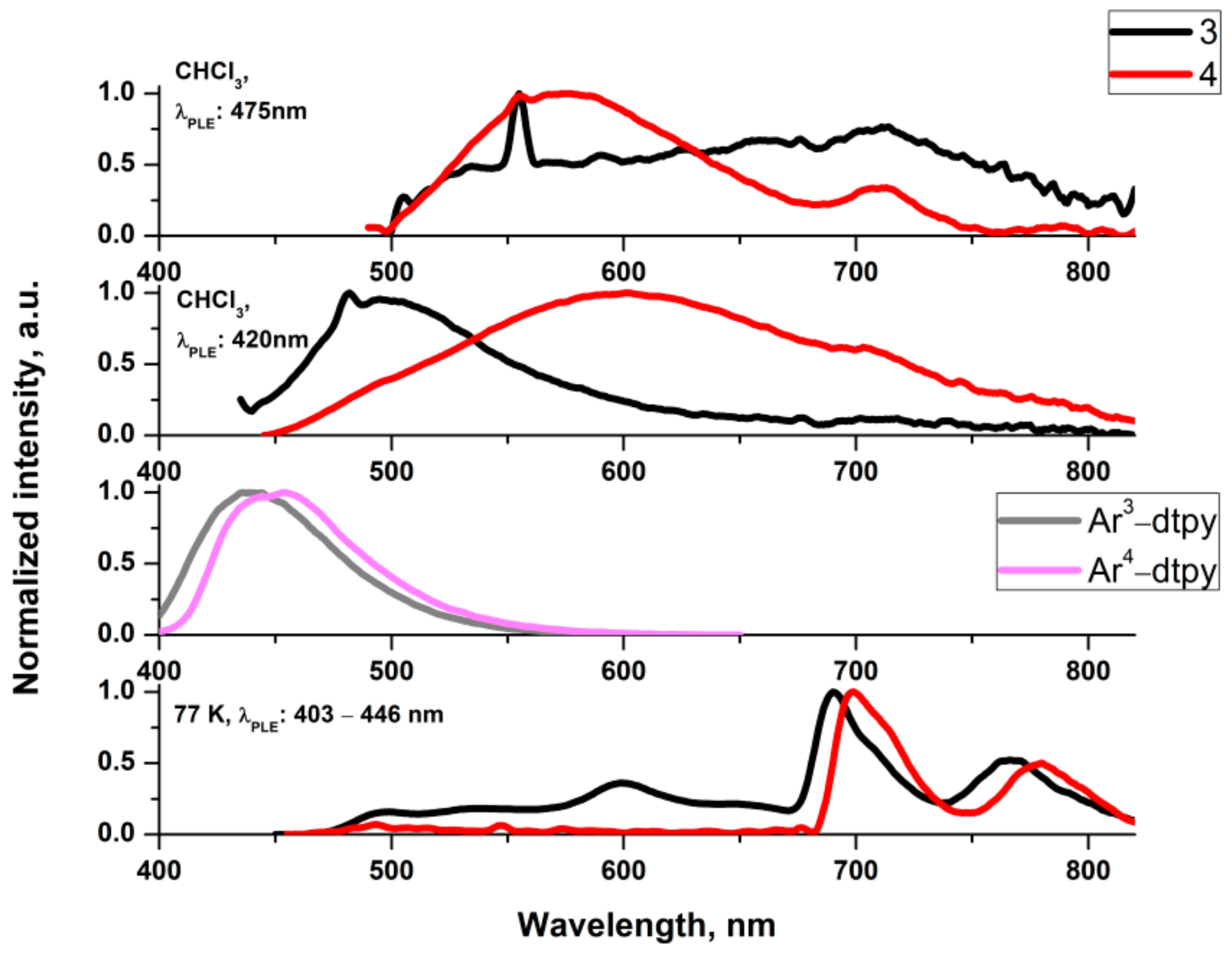
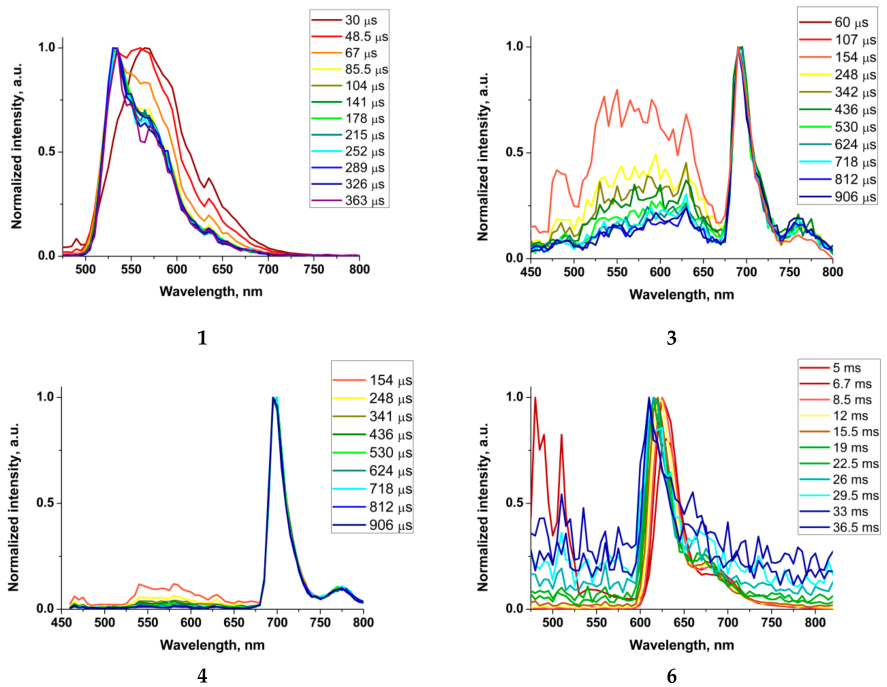
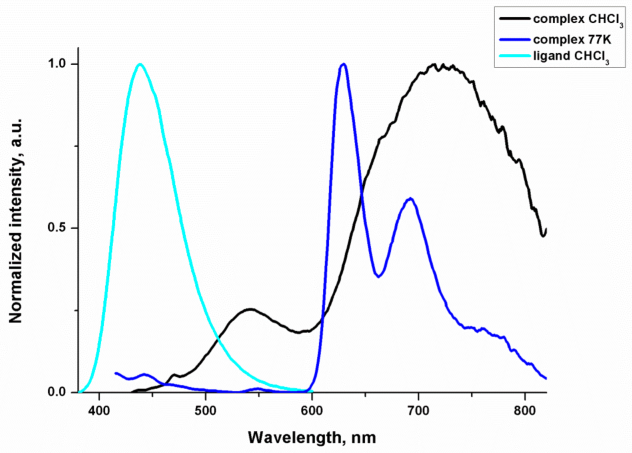
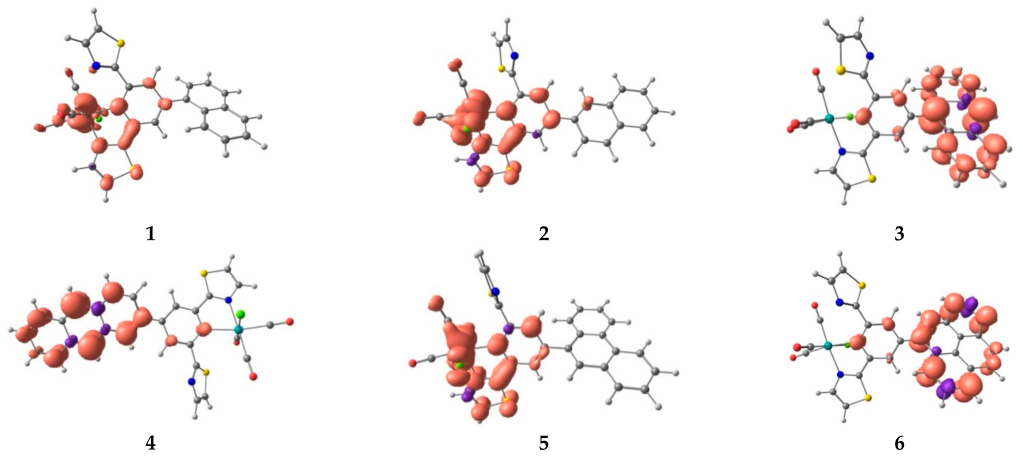

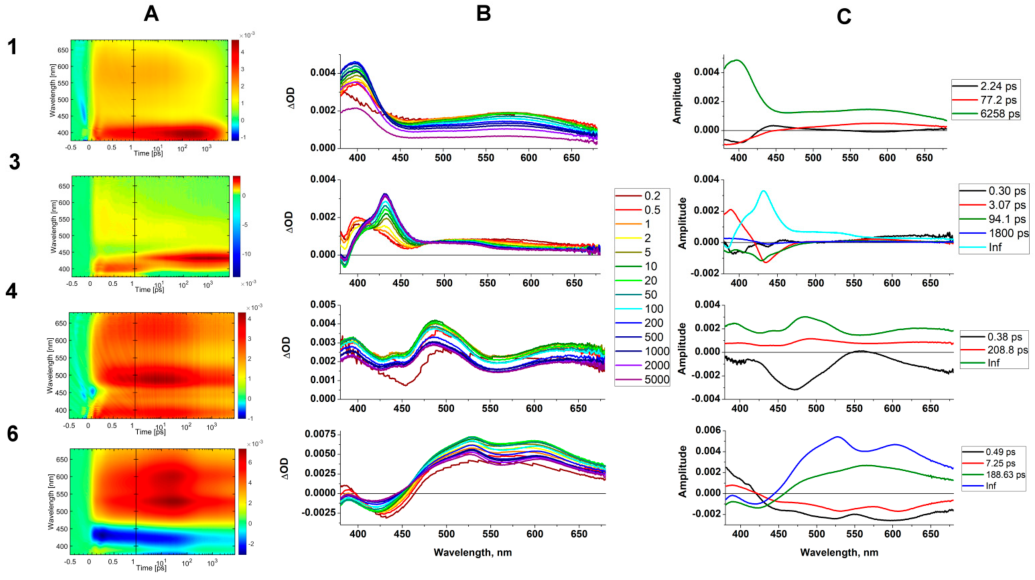

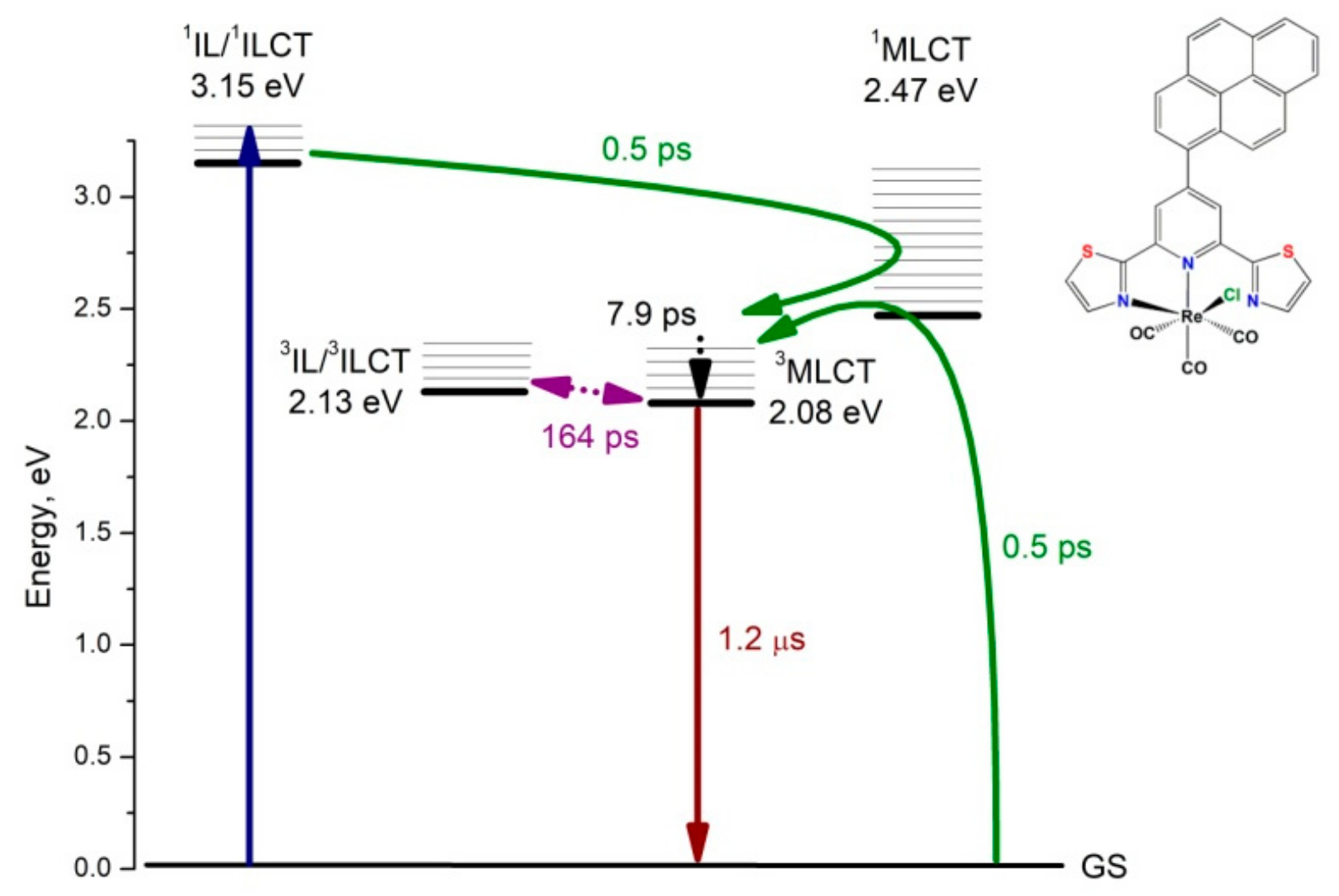
| Compound | IP a (CV) [eV] | EA b (CV) [eV] | Eg(CV) c [eV] | Eg(opt) d [eV] | ||
|---|---|---|---|---|---|---|
| 1 | −1.50 | 0.74 | −5.84 | −3.60 | 2.24 | 2.47 |
| 2 | −1.51 | 0.74 | −5.84 | −3.59 | 2.25 | 2.47 |
| 3 | −1.49 | 0.74 | −5.84 | −3.61 | 2.23 | 2.38 |
| 4 | −1.48 | 0.73 | −5.83 | −3.62 | 2.21 | 2.44 |
| 5 | −1.52 | 0.75 | −5.85 | −3.58 | 2.27 | 2.47 |
| 6 | −1.52 | 0.76 | −5.86 | −3.58 | 2.28 | 2.47 |
| Medium | CHCl3 | 77K | |||||
|---|---|---|---|---|---|---|---|
| Compound | λPLE, [nm] | λPL, [nm] | τav | ΦPL (%) | λPE, [nm] | λPL, [nm] | τav |
| 1 | 463 | 728 (II) | 6.7 ns (II) | 4.25 | 386 | 576 | 16.8 μs |
| 415 | 492 (I), 719 (II) | 3.6 ns (I) | |||||
| 2 | 487 | 731 (II) | 6.7 ns (II) | 3.72 | 386 | 533 sh, 573 | 10.3 μs |
| 415 | 490 (I), 729 (II) | 5.9 ns (I) | |||||
| 3 | 475 | — | — | 6.04 | 403 | 499, 538, 599, 650 (sh) (I) | 4.8 μs (I) |
| 420 | 495 | 4.66 ns | 691, 766 (II) | 5045.8 μs (II) | |||
| 4 | 475 | 575 (I), 711 (II) | 3.16 μs (II) | 5.73 | 446 | 700, 778 | 1996.8 μs |
| 420 | 602 (I) | 6.16 ns (I) | |||||
| 5 | 500 | 728 (II) | 6.3 ns (II) | 0.82 | 385 | 586 | 4.5 μs |
| 415 | 502 (I), 727 (II) | 2.2 ns (I) | |||||
| 6 | 411 | 540 (I), 723 (II) | 3.43 ns (I), 1.20 μs (II) | 6.11 | 413 | 629, 692, 761 | 2626.0 μs |
| 1 | 3 | 4 | 6 | ||
|---|---|---|---|---|---|
| in CHCl3 | in GlyAc | ||||
| time, ps | |||||
| t1 | — | — | 0.30 | 0.30 | 0.50 |
| t2 | 2.24 | 4.03 | 3.07 | — | 7.93 |
| t3 | 77.2 | 612 | 94.1 | 209 | 164 |
| t4 | 6258 | 4300 | 1800 | — | — |
| t5 | — | — | Inf | Inf | Inf |
Publisher’s Note: MDPI stays neutral with regard to jurisdictional claims in published maps and institutional affiliations. |
© 2022 by the authors. Licensee MDPI, Basel, Switzerland. This article is an open access article distributed under the terms and conditions of the Creative Commons Attribution (CC BY) license (https://creativecommons.org/licenses/by/4.0/).
Share and Cite
Maroń, A.M.; Palion-Gazda, J.; Szłapa-Kula, A.; Schab-Balcerzak, E.; Siwy, M.; Sulowska, K.; Maćkowski, S.; Machura, B. Controlling of Photophysical Behavior of Rhenium(I) Complexes with 2,6-Di(thiazol-2-yl)pyridine-Based Ligands by Pendant π-Conjugated Aryl Groups. Int. J. Mol. Sci. 2022, 23, 11019. https://doi.org/10.3390/ijms231911019
Maroń AM, Palion-Gazda J, Szłapa-Kula A, Schab-Balcerzak E, Siwy M, Sulowska K, Maćkowski S, Machura B. Controlling of Photophysical Behavior of Rhenium(I) Complexes with 2,6-Di(thiazol-2-yl)pyridine-Based Ligands by Pendant π-Conjugated Aryl Groups. International Journal of Molecular Sciences. 2022; 23(19):11019. https://doi.org/10.3390/ijms231911019
Chicago/Turabian StyleMaroń, Anna M., Joanna Palion-Gazda, Agata Szłapa-Kula, Ewa Schab-Balcerzak, Mariola Siwy, Karolina Sulowska, Sebastian Maćkowski, and Barbara Machura. 2022. "Controlling of Photophysical Behavior of Rhenium(I) Complexes with 2,6-Di(thiazol-2-yl)pyridine-Based Ligands by Pendant π-Conjugated Aryl Groups" International Journal of Molecular Sciences 23, no. 19: 11019. https://doi.org/10.3390/ijms231911019





